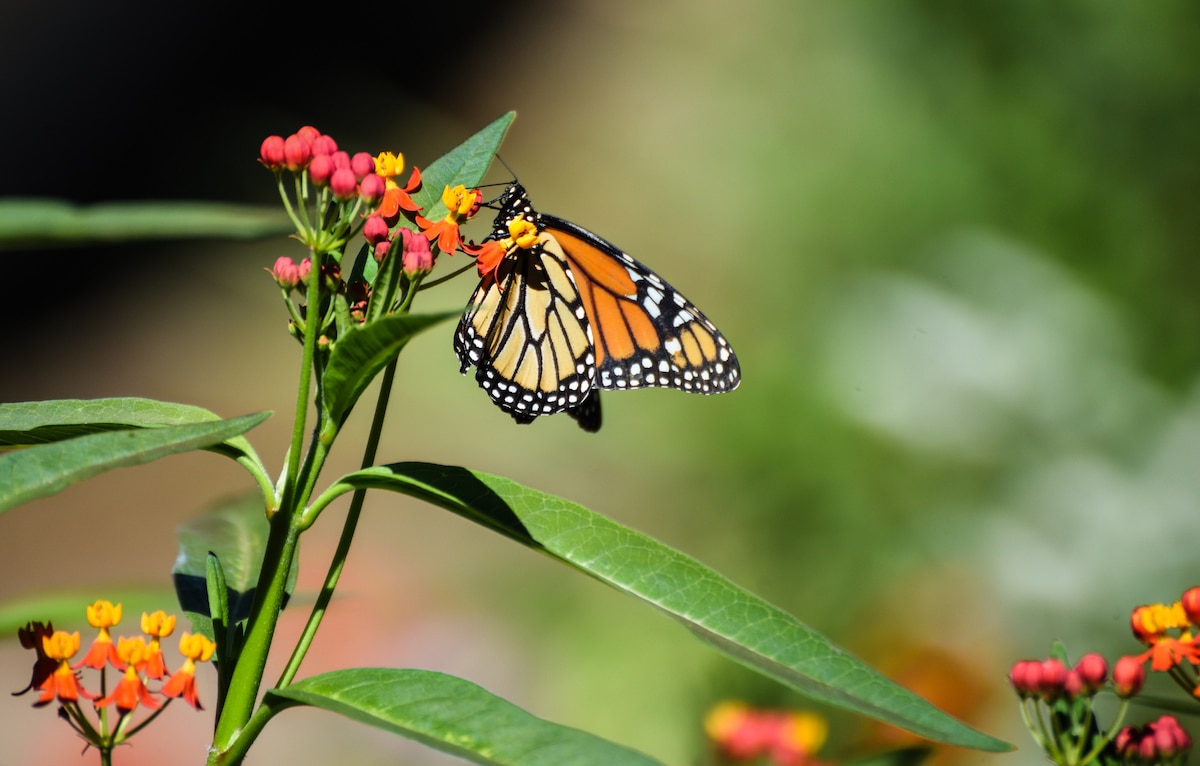

Despite recent news that overwintering monarch butterfly populations have increased 35% in the past year, these graceful creatures are still facing an unsteady future after years of ongoing decline.
Monarch butterflies are a migratory species. Eastern monarch butterflies, which make up the vast majority of monarch butterflies in North America, travel from southern Canada and the northern U.S. to central Mexico every year. Western monarchs fly from various sites across the western U.S. and overwinter all along the Pacific Coast, with some also traveling to central Mexico.
Their numbers have been continuously plummeting since around the late 1990s and early 2000s. All in all, eastern monarch butterflies have declined about 85% since the mid-1990s.
So why are monarch butterflies on the decline? There are a number of factors threatening monarch butterflies, from climate change to habitat loss. Because they travel such a far distance, these critters are impacted by many issues along their migratory path.
1. Habitat Loss
Monarch butterflies face habitat loss for both breeding and overwintering, and many of the threats to these butterflies are connected to one another, leading to even more trouble for the species.
Breeding
Cities, roads, and even agricultural fields have broken up or destroyed many butterfly habitats. Monarchs rely on milkweed plants for breeding, which used to be much more abundant in agricultural fields and along roadsides. Now, pesticides and roadside landscape maintenance has killed off the milkweeds, which monarchs lay their eggs on.
Disappearing Milkweeds
In addition to serving as a spot for the butterflies to lay eggs, milkweed is also important to the larva. Larva depends on the milkweed for food, and they cannot grow to become butterflies without this plant.
Milkweed has been removed for landscaping or urbanization, and in agricultural fields, farmers are using pesticides and modified crops to crowd out other plants, like milkweeds. This leaves less milkweed for monarchs to lay eggs and for their larva to feed on.
Overwintering
Just as you may decide to spend your winter vacation in a warmer location, butterflies migrate each winter. Eastern monarchs fly south to central Mexico to overwinter, meaning they become inactive, while western monarchs fly to the Pacific Coast, particularly in California, for overwintering.
The species cannot survive the freezing temperatures in cooler parts of North America, but they also cannot go somewhere too warm without food for energy. But deforestation is destroying the oyamel fir stands in forests where the butterflies spend winter. There are some bans on logging in these known butterfly habitats, but some projects are still greenlit and illegal logging also still occurs.
2. Pesticides
Pesticides, including neonicotinoids that also threaten bees and other chemicals designed to kill off insects and pests considered threats to crops, are a large contributor to monarch butterfly decline. Aside from killing off butterflies directly, these chemicals can prevent milkweed and other native plants from growing.
RoundUp and Other Herbicides
Major crops today, like corn and soybeans, are modified to be “RoundUp-ready,” so farmers can spray RoundUp to kill off weeds without also killing off their crops. But the extensive use of glyphosate, the active ingredient of RoundUp, completely kills off milkweed, which adult butterflies need to lay eggs and larva needs for food.
Insecticides
Neonicotinoids are used to kill insect pests of crops or landscape plants, but they are lethal to any insects that come into contact with them. These chemicals, which are similar to nicotine, can be applied to plants via spray or applied to soil. Plants fully absorb these insecticides, becoming toxic to insects that eat any parts of the plants.
Neonicotinoids have already been banned in the EU for their detrimental impact, but they are still prominent in the U.S. These chemicals frequently contaminate milkweed as well as other plants’ nectar, and recent studies show that exposure to such insecticides can decrease the chance of larval survival for monarchs.
3. Climate Change
We’re all impacted by climate change, butterflies included. Warming temperatures changes environmental cues that trigger migration, but butterfly survival is also impacted by temperatures. Temperature shifts can also impact when butterflies reproduce and hibernate.
Monarchs may need to adapt to a new migratory path depending on temperatures and how the plants they rely on for food and breeding also are affected by climate change. For overwintering, the butterflies must go somewhere where temperatures are not too cold for survival but are also not too warm, which can cause the creatures to use up too much of their stored energy. Further, extreme weather events triggered by climate change also pose a threat to the species.
The biggest threats to monarch butterflies are all related to one another, and it will take a multifaceted approach to improve the species’ chance of survival.
“Priorities for climate-informed monarch conservation should include restoring and increasing the extent of habitat with appropriate milkweed species and nectar sources,” WWF recommends. “The public at large can contribute to this effort by planting backyard habitat. Increased monitoring of populations is also important, and citizen science efforts can contribute to this. It is also essential to maintain and restore overwinter habitat, reduce the use of herbicides and pesticides, and address issues related to land-use change.”

 233k
233k  41k
41k  Subscribe
Subscribe 